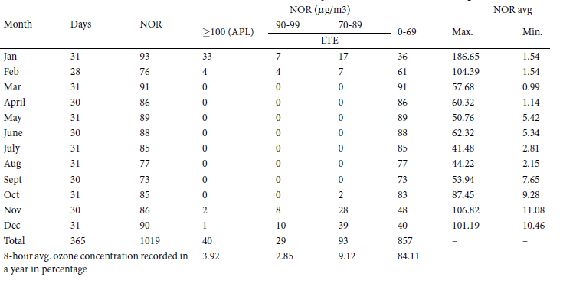


Indian Journal of Science and Technology
Year: 2020, Volume: 13, Issue: 26, Pages: 2593-2600
Case Report
Dileep Geddam1*, Dr. Viswanadha Kumar Giduturi2, Vijaya Ratna3
1Assistant Professor, Department of Architecture,, College of Engineering (A), Andhra University, 530003
2Professor, Department of Architecture, College of Engineering (A), Andhra University
3Student of Master of Environmental Planning, Department of Architecture, College of
Engineering (A), Andhra University
*Corresponding Author
Email: [email protected]
Received Date:07 May 2020, Accepted Date:10 July 2020, Published Date:27 July 2020
Objectives: The present study was focused on the 8-hour average concentration of ground-level ozone in the city of Visakhapatnam for three years in a row, i.e. 2017, 2018, and 2019, and the effects of ozone on human life, the environment, and building materials. Method: The data of 8-Hour average groundlevel ozone concentration was collected for the study from the Central Control Room for Air Quality Management – All India, Central Pollution Control Board. Data available from the source were analyzed and compared to the NAAQS, India and the data was tabulated and showed specifically the number of times the 8 Hour average ground-level ozone surpassed in a month, for a clearer understanding. Findings: Study results show that the air quality of ozone levels during winters showed maximum unhealthy hours. The trends of maximum recorded 8-Hour average concentration of ozone levels in a day are also increasing year by year. Recommendations: It is recommended to be safe indoors during high ozone days for the people with comorbidities, children, Women in pregnant, people active in outdoor activities and it is further advised to reduce ozone exposure it's safe to wear washable 6-layer N99 and PM2.5 face mask during winters especially from November to February. Schools may be cautioned to discontinue the open-air physical activity during this period.Creating ozone forecasts accessible to the public is important, and the local and national laws should be strengthened to combat ozone pollution.
Keywords: Asthma; contamination; ecosystems; urban vegetation; ozone; mortality
©2020 Geddam, Giduturi, Ratna.This is an open-access article distributed under the terms of the Creative Commons Attribution License, which permits unrestricted use, distribution, and reproduction in any medium, provided the original author and source are credited. Published By Indian Society for Education and Environment (iSee)
Subscribe now for latest articles and news.